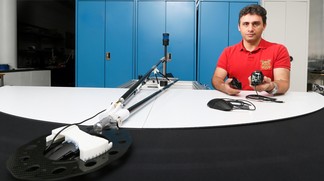May 19 2015
An EPFL post-doctoral researcher at Logitech has developed an algorithm that gives a computer mouse a nearly-unlimited tracking speed. It is based on the combining of an optical sensor with a system based on accelerometers and gyroscopes. Already on the market, this device is a successful example of collaboration between research and industry.
 © 2015 Alain Herzog
© 2015 Alain Herzog
From the outside, this powerful device looks like a conventional mouse: therein lies its strength. While it responds like a normal mouse, it can track the user movements – up to at least five times the rate tolerated by its competitors. This supermouse is designed for amateur gamers and champions of professional e-sports alike. Caught up in the action, gamers could actually perform very rapid movements with frequent direction changes. This pushes an optical mouse to its limits.
An all-terrain mouse
The designer of this competitive mouse, Arash Salarian, worked in 2010 at the Laboratory of Movement Analysis and Measurement (LMAM) developing an all-terrain mouse that would work as effectively on a mousepad as on glass or any other surface. Optical sensors operate on the basis of successive images, and they require a minimum amount of contrast to function properly. Technology based on gyroscopes and accelerometers has the advantage of being usable even on the most uniform media. The prototype developed with this technology, called “inertial,” functions very well at high speeds, but becomes less reliable when used in a traditional office.
This secondary advantage of high speed tracking, allowed the inertial technology to rebound toward hybridization with the optical sensor: to seamlessly switch between the inertial and optical modes during fast paced action scenes in computer games. The idea of the CTI project that followed was thus to combine tracking at low speed using the optical sensor algorithms, with high-speed tracking using inertial sensor. Hence, the name: “Fusion.” A 32-bits microcontroller calculates the trajectory every millisecond and let the inertial system to take over beyond a certain speed limit. This enhanced mouse supports speeds five times higher than those of its counterparts using the same optical sensor.
Specifically developed tests
While gamers, according to blogs and specialized sites, appreciate a substantial difference in the fluidity of action when using this type of equipment, “it is very likely that it supports an even greater speed,” says Arash Salarian, who now works at Logitech. “The limit we measured only corresponds to the upper limit of test instruments.” For the record, the measurement tools traditionally used to calibrate the mouse are insufficient for measuring such high speeds. It is another EPFL lab (LASA) that certified the test equipment specifically developed by Logitech.
On the market, it’s called “Logitech G402 Hyperion Fury Gaming Mouse.” The mouse is one of many examples of products resulting from a collaboration between EPFL and Logitech, between applied research and commercial development, which has lead to innovative mass production for the global market.